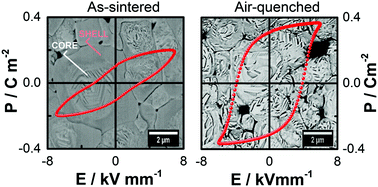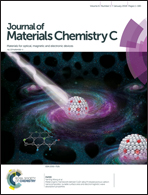Chemical heterogeneity and approaches to its control in BiFeO3–BaTiO3 lead-free ferroelectrics†
Abstract
1 mol% MnO2 was used to improve electrical resistivity of lead-free 0.75BiFeO3–0.25BaTiO3 (75BFBT) ferroelectric ceramics; the materials were perovskite structured with major rhombohedral (R3c) phase. The method of incorporation of MnO2 was found to exert a significant influence on the structure, microstructure and electrical properties. Chemical heterogeneity in the form of core–shell grain microstructures was observed when MnO2 was added into the undoped calcined powder, in contrast to the relatively homogeneous materials that resulted from adding MnO2 into the precursor oxide mixture prior to calcination. Compositionally graded regions were detected across the grains consisting of a BF-rich core and BF-depleted shell. The occurrence of core–shell type microstructures led to various characteristic features including a high cubic phase fraction, contrast between ordered ferroelectric domain configurations in the rhombohedral core and the relatively featureless pseudo-cubic shell, constrained ferroelectric domain switching, and two distinct anomalies in dielectric permittivity at temperatures of 485 and 635 °C. The latter features are attributed to separate phase transitions in the relaxor ferroelectric shell and normal ferroelectric core regions respectively. The application of a thermal quenching procedure caused the formation of ferroelectric domain structures throughout the microstructure and resulted in dramatically enhanced ferroelectric switching behaviour. For example, the remnant polarisation of the as-sintered 75BFBT ceramic increased from 0.06 to 0.31 C m−2 after air-quenching. These effects are tentatively attributed to nanoscale phase segregation in the shell region of the as-sintered ceramics, resulting from thermodynamic immiscibility between the BF and BT solid solutions.



 Please wait while we load your content...
Please wait while we load your content...